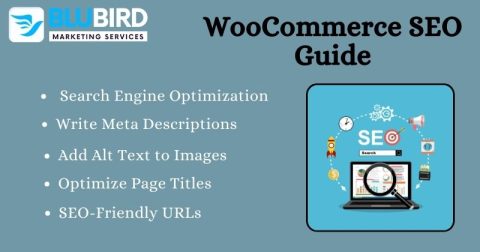Optimizing your online WooCommerce store to rank sufficiently in Search Engine Results Pages is known as WooCommerce SEO. More sales and more organic traffic are interrelated with a higher position. WooCommerce SEO uses a combination of optimization strategies to boost your site’s orientation in organic search results. You will have more opportunities to convert visitors into paying clients if it is easy for them to find your website. The more SEO you can improve, the less money you’ll probably need to spend on other marketing techniques like sponsored social media advertising.
A Simple Guide to SEO for WooCommerce:
Through the wooCommerce SEO guide, you can quickly optimize your stores and concentrate on offering customer service and increasing sales.
1. Optimise the Titles of Your Product and Category Pages:
Product and category titles play a major role in WooCommerce SEO, but they also facilitate interaction with customers. Improving your SEO title likewise boosts the possibility that your categories and goods will show up in pertinent search results, increasing revenue as well as traffic. When relevant search terms appear in the title tags of your items and categories, search engine algorithms return relevant results. You should also write attention-grabbing, concise titles. If they are very lengthy, they can be compressed into the outcomes of a search.
2. Utilize Meta Descriptions:
In WooCommerce SEO, descriptions for meta tags are also very important. In the SERPs, these short excerpts show up beneath page names. Users can understand sites before clicking on them because of the brief descriptions. Because meta descriptions have the power to affect the number of clicks on a result, they are critical to SEO. A well-written meta description can raise your website’s Click-Through Rate, which raises your search engine rankings.
3. Optimize Your Product Slugs:
The product slugs, or permalinks, are another area where you can enhance WooCommerce SEO and provide the search engines with information about the product. The URLs that are linked to all of the products in your store are called product slugs. Whenever feasible, try to include keywords in your slugs. These are the search engine terms (or the words you think people use to hunt for and locate your product) that you expect it to be ranked within.
4. Internal links:
The internal relationships are the associations that bind your website’s pages together if you can imagine each page as an entity. They are links that take visitors to different pages on your website. We link to additional items that may be of interest to you via internal links. When you add them, individuals will visit your website for more.
5. Avoid Duplicate Content:
A web page that is substantially identical to your website or one that is quite comparable to it is considered to be a duplicate. Google might remove duplicate pages from their rankings if they discover that you have too many. It might be worthwhile to investigate duplicate material.
- Regularly publish Press Releases
- You can use the same content in multiple places on your website.
- Different domains could have the same or similar content.
You should ensure that your content is original. Keep the pages with the highest traffic and ranking. Next, redirect duplicate pages to the page you want. Redirects are necessary when you move from one e-commerce platform to another. To maintain page rankings, you will need to redirect old platform URLs. You may need both pages to be maintained sometimes, even if they are not identical.
6. Track WooCommerce Customers in Google Analytics:
Information is an especially crucial component of a successful SEO campaign. You should find out how people found your store, where they are coming from, what products they have looked at, and what people are doing on your WooCommerce website. You can track all of this data with Google Search Analysis, but setting it up right is rather difficult.
7. Keep Your URLs Short:
Optimizing your WooCommerce URLs is essential if you want to improve SEO performance. Long, complicated URLs can confuse Google and other search engines, thereby hurting the results of your on-page SEO efforts. Make sure to maintain URLs shorter and use keywords where you can, focusing on readability.
8. Enable Breadcrumbs:
Although WooCommerce encourages and supports the employing of breadcrumbs, their impact on user experience won’t be felt unless you enable them. Maybe probably are using certain plugins that deal with breadcrumbs. WooCommerce has some basic breadcrumb functionality, but using the Yoast WooCommerce SEO plugin can allow you toward more specifically tailor your breadcrumbs configuration.
9. Secure Your Site:
A key problem for internet retailers is site security. You must ensure your client’s safety during the purchasing process because you are handling their sensitive information. Verify that security certificates are being used for all of your webpages (SSL, or secure socket layers; sometimes known as activating HTTPS), but particularly for the WooCommerce store. Ensure that plugins—particularly those for WooCommerce—are always updated. Customers will feel safer entering their financial details as a consequence.
10. Ensure Mobile Friendliness:
To make the most of the effects of your WooCommerce SEO strategy, you must optimize the website for both desktop and mobile platforms. If a website is difficult to use on mobile devices, even the best one may lose visitors. The majority of WordPress websites make mobile device optimization easy. Simply check that each page displays as you intend by previewing it in different ways.
Conclusion
WooCommerce SEO is essential if you want customers to discover your online business. Although the extension is already SEO-friendly, there are a few recommended practices you need to adhere to to properly optimize your website. You can utilize several strategies to improve your WooCommerce store, as we covered in this post. Among the most crucial ones is adding keywords to your metadata, titles, and descriptions. Using categories, tags, and breadcrumbs is also crucial to building a well-organized navigation system. Additionally, you can master WooCommerce SEO with the use of tools like Rank Math and our Divi Builder app.






